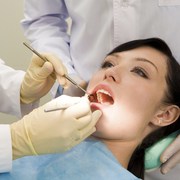 MonkeyBusiness Images/PhotoSpin
MonkeyBusiness Images/PhotoSpin
A dental crown is a covering that is put on a tooth either to make it stronger, or to make it look better. A crown may also be called a cap.
A crown can keep a cracked tooth from falling apart. It can build up a tooth that is broken or eroded.
It can cover and hold together a tooth that is mostly composed of a big filling of a cavity or cavities.
A crown can secure a dental bridge. It will go over top of a dental implant. A crown will cover a tooth that is discolored or badly shaped.
If a filling is inadequate for the situation, you may need a crown. Crowns cover more tooth area than veneers will, extending over the entire tooth to the gum line.
You can get temporary or permanent crowns.
Your dentist can make a temporary crown out of stainless steel or acrylic. This type of crown is used while you wait for a permanent crown.
A dental laboratory makes permanent ones. These are made from metal, porcelain with metal, resin, ceramic, or porcelain.
Metal crowns are made from gold alloy, base-metal alloy like chromium or nickel, or other alloys such as palladium. Metal crowns require less of the original tooth being removed. Nearby teeth experience less wear when a metal crown is used.
Dental crowns that are porcelain-fused-to-metal differ from metal crowns in that they can be matched to the color of your teeth. More wear to other teeth will occur however. The porcelain can chip, and the metal underneath may show darkly through the porcelain.
Dental crowns that are all resin cost less than the other types. They are vulnerable to erosion though and breakage.
Ceramic or porcelain crowns can match to your own teeth better than others. If you have a metal allergy this may be a good choice for you. They are subject to wear and tear and can erode neighboring teeth more than resin or metal.
Your dentist will make every effort to create a crown that looks natural and fits in appearance with your other teeth. The color, length and shape of your teeth will be taken into consideration.
Crowns can last between five to eight years. Good care may make them last longer. Poor care may mean they need replacing sooner.
Bruxism or grinding of the teeth are detrimental to a crown. If you stay away from ice and hard food, this will help your crown to last a good long time.
Sources:
Dental Health: Dental Crowns. Retrieved Oct. 23, 2012.
http://www.medicinenet.com/dental_crowns/article.htm
What Are Crowns? Retrieved Oct. 23, 2012.
http://www.knowyourteeth.com/infobites/abc/article/?abc=w&iid=300&aid=1202
Visit Jody's website and blog at http://www.ncubator.ca and http://ncubator.ca/blogger
Reviewed October 24, 2012
by Michele Blacksberg RN




Add a Comment1 Comments
Thanks for sharing. Whether it be porcelain crowns or traditional PFM (porcelain fused to metal) crowns please be diligent in your home care. They will fail if not properly taken care of. I cannot stress enough the importance of good dental hygiene as well as regular dental examinations.
October 24, 2012 - 9:32amMarielaina Perrone DDS
Cosmetic Dentist Henderson Nevada
This Comment